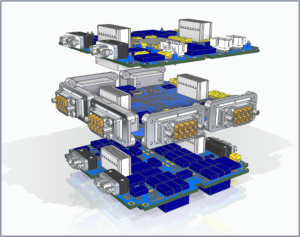SpaceFibre
SpaceFibre is the latest generation of SpaceWire network technology for spacecraft on-board data-handling applications. It runs over electrical or fibre-optic cables, operates at very high data rates, and provides in-built quality of service (QoS), and fault detection, isolation and recovery (FDIR) capabilities. SpaceFibre provides high-performance, high-reliability and high availability, making it ideal for many demanding network applications, including spacecraft payload data-handling. A SpaceFibre network is made up of links, endpoints and routing switches. Links connect endpoints and routing switches together to form a SpaceFibre network.
Hi-SIDE Project
The Hi-SIDE project is a European Union project carried out by several leading aerospace organisations from across Europe. It developed critical satellite data-chain technologies for handling and transferring data from instruments to processing and storage elements on-board the spacecraft, and to the downlink transmitters that send data to ground. Hi-SIDE has made substantial advances in the major elements of the data chain including networking, processing, compression, and downlink transmission to support the next generation of data intensive missions. The data chain elements are interconnected via a SpaceFibre network. The Hi-SIDE project culminated in a comprehensive demonstration incorporating all the critical elements of the High Speed Data Chain (HSDC) from instrument to ground-station. It was awarded The Innovation in Space Award by the European Space Forum.
STAR-Tiger
The STAR-Tiger SpaceFibre routing switch, shown in Figure 1, is the primary element of the payload data-handling network for the Hi-SIDE project, which is used for transferring data at high data-rates between instruments, mass-memory, data compressor, data processor and downlink transmitters. It is also used to provide the control network used by the control computer to control both the network and the equipment attached to the network.
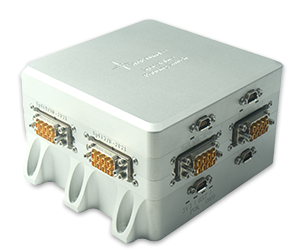
Figure 1: STAR-Tiger SpaceFibre Routing Switch
The STAR-Tiger routing switch is a high-performance SpaceFibre routing switch implemented using STAR-Dundee SpaceFibre IP. It has the following characteristics:
- Ten SpaceFibre ports
- Two quad-lane ports
- Eight dual-lane ports
- Lane speed up to 6.25 Gbit/s
- Port data rate 9.6 Gbit/s dual-lane port and 19.2 Gbit/s quad-lane port
- Two SpaceWire interfaces for reprogramming the STAR-Tiger FPGA
- Spaceflight TRL5/6 level design
- Electronic components are radiation tolerant EM flight parts or industrial/commercial equivalents of flight parts
- Power consumption 14.2W typical at 20 °C, all links running with lanes speeds of 6.25 Gbit/s
- Conduction cooled
- Operating temperature range: -25 to +55 °C
- 108 x 108 x 68 mm (excluding mounting brackets)
STAR-Tiger comprises three circuit boards (see Figure 2).
- A power supply board (bottom) which has nominal and redundant power input selection and delivers the five main power rails to the FPGA. Other power rails are supplied by regulators on the other two boards. Texas Instruments radiation tolerant power supply components are used.
- An FPGA board (middle) containing the Xilinx KU060 FPGA. The PCB footprint accommodates either the commercial/industrial part or the radiation tolerant part. An industrial grade FPGA was used. The FPGA is surrounded by six Elara connectors which carry the SpaceFibre electrical signals. Each connector provides four lanes of SpaceFibre. Two connectors each carry one quad-lane port and the other four connectors each carry two dual-lane ports.
- A configuration and scrubbing board (top) which is used to configure and monitor the KU060 FPGA. Configuration is from EEPROM or via a SpaceWire interface. The EEPROM can be programmed over SpaceWire.
Figure 2: STAR-Tiger Routing Switch Board Arrangement
These three boards are shown in Figure 3 in various stages of integration with the STAR-Tiger housing.
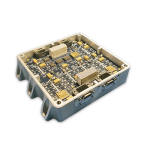
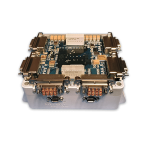
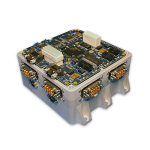
Figure 3: STAR-Tiger (a) Power Supply Board (b) FPGA and (c) Configuration Board in Housing
The STAR-Tiger SpaceFibre Routing Switch forms the heart of the SpaceFibre network that connects the instruments, data-handling and downlink telemetry elements together. STAR-Tiger is capable of data rates up to 19 Gbit/s on its quad-lane ports and 9.6 Gbit/s on it dual-lane ports, with an aggregate throughput (all ports in both directions) of around 200 Gbit/s. STAR-Tiger has been developed with radiation tolerant components to a TRL level of 5/6 demonstrating the capabilities of SpaceFibre for future on-board payload processing networks.
Acknowledgement
The Hi-SIDE project received funding from the European Union’s Horizon 2020 research and innovation programme under grant agreement No 776151.

